Abstract
Simulating chemical reactions plays a vital role in research, education, and various industries. Conventional laboratory methods for testing these reactions can be both time-consuming and expensive, necessitating specific conditions, chemicals, and safety measures. Virtual chemical simulators, such as Chem Tech, provide students, researchers, and professionals the opportunity to explore reactions immediately without the need for physical materials. ChemTech is an advanced application designed to facilitate the simulation of chemical reactions efficiently. This application aims to enable users to simulate chemical reactions instantly and learn about name reactions and elements through an interactive periodic table interface.
Keywords
Chem Tech, Periodic table , Reaction simulation , Name reaction , Benzene Reaction.
Introduction
In the realm of pharmaceutical chemistry, specialized software applications are essential for the design, analysis, and visualization of chemical compounds. Tools such as Chem Draw and Chem Office are extensively utilized for creating and modeling chemical structures, enabling researchers to produce accurate molecular diagrams and reactions.[1][2] MDL ISIS serves as a robust platform for managing chemical data, providing database solutions and structure search functionalities. Chem sketch is favored for its capabilities in drawing and editing chemical structures, as well as generating 3D models, while Maestro stands out as a comprehensive molecular modeling software, widely employed in computational chemistry, molecular dynamics simulations, and drug design.[3] These applications significantly boost productivity, ensure precision in molecular design, and promote a deeper comprehension of chemical behaviors, rendering them essential in the pharmaceutical sector.[4]
Apps referred are :
- Chem office
- MDL ISIS
- Chem sketch [6]
- Maestro [7]
Chemtech
1.Introduction
"Chem Tech" is an innovative application designed for simulating chemical reactions, aimed at enhancing the efficiency of this process and to get easy understanding of Name reactions and Benzene reactions. Utilizing Python and the Stream lit framework, it also incorporates Google’s generative AI to deliver real-time simulations based on user inputs. The main goal of the application is to enable users to quickly simulate chemical reactions while gaining insights into name reactions and elements through an interactive periodic table. This report delves into the features, architecture, performance metrics, and practical applications of "Chem Tech," highlighting its essential components such as chemical reaction simulation, the name reactions feature, and the interactive periodic table. We are extensively utilizing technology for simulation chemical reaction, offering a tech- savvy approach to self-learning in the field of chemistry. This technological application facilitates an innovative and accessible method for mastering the concepts of chemical reaction.

Fig. 2: Homepage of application
Technology Stack
2.1 Python
Python was selected for its ease of use and extensive library support. Its proficiency in scientific computations and robust ecosystem made it a suitable choice for creating a chemistry-oriented simulation tool.
2.2 Stream lit
Stream lit served as the framework for developing the web application. Its intuitive design facilitated the swift creation of a responsive web interface, enabling users to enter their specifications, view visualizations, and receive simulation outcomes in real-time.
2.3 Google Generative AI Integration
The simulation engine of the application is powered by Google’s Generative AI, which allows ChemTech to produce precise and immediate results for chemical reactions. [10] This integration occurs through API calls, where the prompt is already defined in the back-end and users have to give appropriate inputs.
3.Key Features of Chem Tech
3.1 Basic Chemical Reaction Simulator
The chemical reaction simulation stands as the primary feature of Chem Tech. Users can enter a reaction equation or description, and leveraging advanced AI capabilities, the application produces a simulated output within seconds.
3.2 Name Reactions, Benzene Reactions and Catalyst Information
Chem Tech serves as an educational resource by presenting a compilation of 12 significant name reactions and 5 benzene reactions. For each reaction, users can delve into various sections, including:
- Definition
- Mechanism
- Involved Catalyst
- Required Conditions for the reaction
Moreover, users can simulate these reactions with real-time inputs to observe their behavior in a controlled setting.
3.3 Interactive Periodic Table
The interactive periodic table enables users to filter elements according to various criteria:
- Group
- State (Solid, Liquid, Gas)
- Electrical Conductivity
- Acidity
Upon selecting an element, users gain access to extensive information, such as:
- Name
- Symbol
- Valency
- Group Number
- Melting Point
- Boiling Point
- Electronic Configuration
- Electrical Conductivity
This feature serves as a comprehensive tool for in-depth study of the periodic properties of elements. [11].
4.Detailed Walkthrough of Features
4.1 Basic Chemical Reaction Simulator
The fundamental simulation feature accepts inputs in the form of chemical reactions. Once an input is provided, it interacts with the Google generative AI model, which processes the information and delivers the output of the reaction. The output encompasses list of reactants and their products with various properties like density, molecular weight, etc in tabular form.
4.2 Name Reactions Features
The name reactions feature includes an extensive dataset of 12 widely studied reactions, such as:
- Pinnacle-Pinacolone rearrangement
- Hafman's reaction
- Baeyer-Villiger oxidation
- Benzilic acid rearrangement
- Beckmann's rearrangement
- Claisen-Schmidt condensation
- Schmidt rearrangement
- Clemmensen reduction
- Wolff rearrangement
- Oppenauer oxidation
- Dakin reaction
- Birch reduction
Each reaction is accompanied by an in-depth examination of its mechanism and the necessary conditions for its occurrence.
- User Interface and Usability
The ChemTech user interface, developed with Streamlit, features a streamlined and user- friendly design. Users encounter three main components:
- A text input area for chemical reaction entries
- A section for naming reactions with comprehensive details
- An interactive periodic table equipped with filtering capabilities.
The design emphasizes user experience, incorporating responsive elements and a seamless simulation workflow. All reactions and data points are clearly displayed, with interactive visuals aiding users in grasping intricate concepts. Students as well as professors can use this application for easy understanding of chemical reactions.
- Back-End Architecture and API Integration
6.1 API Integration for Reaction Simulator
The core backend functionality is centered on API interactions with Google's generative AI model. Upon receiving user input, the application forwards this data to the API, retrieves the processed information, and presents the simulation outcomes.
6.2 Dataset
- Information on named reactions
- Properties of elements for the interactive periodic table
- User preference and session information
7.Simulation Algorithm and Mechanisms
7.1 Reaction Modeling Algorithms
Google's generative AI employs sophisticated reaction modeling algorithms to forecast outcomes based on user inputs. These algorithms take into account variables such as energy changes, reaction kinetics, and equilibrium states.
7.2 Data Flow for Name Reactions
The named reactions module accesses a pre-existing dataset that contains information about each reaction. When a reaction is chosen, the application retrieves and presents the relevant details, allowing the user to simulate the reaction interactively.
8.Case Studies
8.1 Simulating a Chemical Reaction
For instance, simulating the combustion of methane. The user inputsCH? + O? -> CO? + H?O , and the simulation estimates the energy released, structure of products, its physicochemical properties and other details about the reaction.
, and the simulation estimates the energy released, structure of products, its physicochemical properties and other details about the reaction.
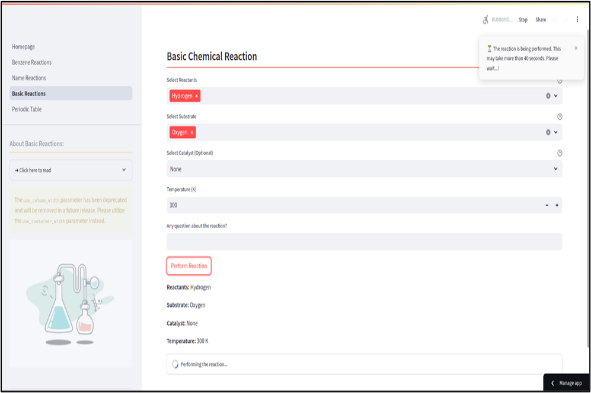
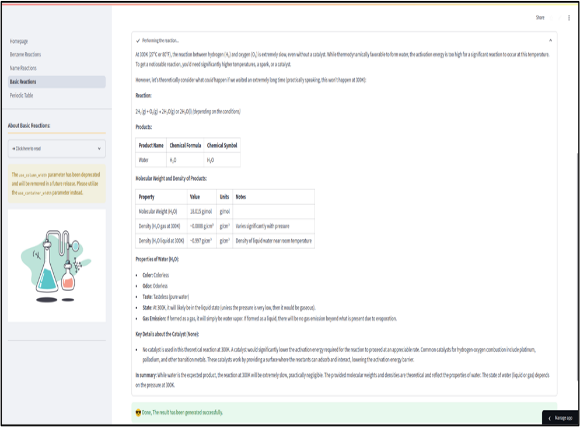
Fig. 3: Basic Chemical Reaction Simulation
8.2 Accessing Name Reactions Data
8.2.1 Preview tables of reactions
The preview tables present a compilation of name reactions along with brief explanations and the necessary conditions for each. Additionally, there is a separate table dedicated to benzene reactions, which outlines the types of reactions, a concise overview of their mechanisms, and the required conditions. This format offers a clear understanding of the reactions, making it beneficial for quick study, review and revision. [9]

Fig 4: Preview table of Name reactions
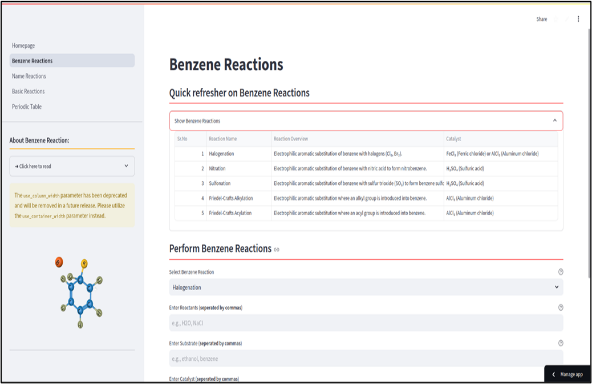
Fig. 5: Preview table of Benzene reactions
8.2.2 Name Reactions
For instance, by selecting Beckmann rearrangement reaction from the list of name reactions, the application reveals the reaction mechanism and enables users to simulate the conditions necessary for this reaction to occur.


Fig. 6: Name Reaction Simulation
8.2.3 Benzene Reactions
In the case of benzene reactions, choosing the Halogenation reaction from the provided options allows the application to present detailed information about the reaction, including its mechanism and necessary conditions. Additionally, users get the capability of simulating the reaction based on these specified conditions.

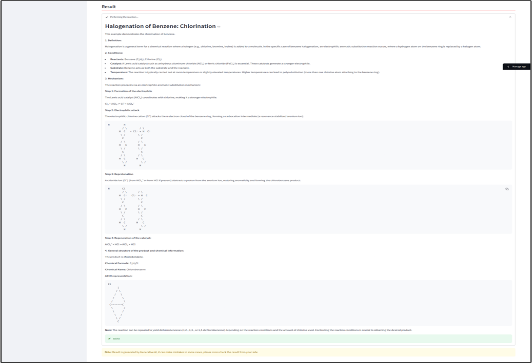
Fig. 7: Benzene Reaction Simulation
8.2.4 Utilizing the Interactive Periodic Table
For example, a user can filter the elements to display only those in group 1 that are in a liquid state at room temperature. The application then showcases the pertinent elements along with their properties. The details regarding the selected element will be presented, encompassing its physicochemical parameters.
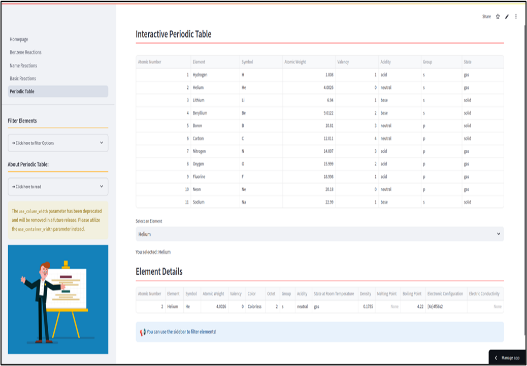
Fig. 8: Interactive Periodic Table
Performance Evaluation and Benchmark
9.1 Load Testing
The application has been evaluated to manage multiple simultaneous simulation requests without experiencing significant delays.
9.2 Simulation Effectiveness
Thanks to its integration with Google AI, the reaction simulations are completed in under a minute, depending on the complexity of input provided.
10.Security and API Key Management
To maintain secure API communications, the application employs encryption for all exchanges involving API keys. Additionally, user authentication and session management are conducted securely to prevent unauthorized access.

Fig. 9: Advantages of Chem Tech
RESULTS AND DISCUSSION
Chem Tech serves as a robust and user-friendly web-based platform for simulating chemical reactions, examining name reactions, and engaging with the periodic table. It utilizes Python, Streamlit, and Google’s AI technologies to provide real-time simulations that simplify intricate chemical processes for users in both educational and professional settings. ChemTech enhances accessibility through its web-based platform and real-time AI integration. It streamlines the learning and experimentation experience, allowing users to quickly simulate intricate chemical reactions ,obtain detailed information on significant Named reactions and Benzene reactions, navigate an interactive periodic table with sophisticated filtering capabilities. Upcoming enhancements for ChemTech may include expanding the collection of name reactions, introducing more detailed filters for the periodic table, adding molecular visualizations and 3D pathways for reactions.
ACKNOWLEDGMENT
We chose Stream lit for Chem Tech due to its simplicity, seamless Python integration, and free deployment strategies. It enabled real-time simulations, interactive periodic table features, and easy access for users at no cost.
REFERENCES
- Halford, Bethany (2014). "Reflections On Chem Draw". C&EN. 92 (33): 26–27. Retrieved 20 August 2014.
- Evans, David A. (2014-10-13). "History of the Harvard Chem Draw Project". Ange wandte Chemie International Edition.
- Kaushik, Manish (2014-04-04). "A review of Innovative Chemical Drawing and Spectra Prediction Computer Software". Mediterranean Journal of Chemistry. 3 (1): 759– 76
- Tool, D., Evolution, T., Solution, C. & Communication, C. Beyond a Drawing Tool : The Evolution of a Comprehensive , Chemically-Intelligent Solution for Chemistry Communication
- https://chemistrydocs.com/
- https://en.wikipedia.org/wiki/ACD/ChemSketch
- https://www.schrodinger.com/platform/products/maestro/
- https://docs.streamlit.io/develop/api-reference/charts
- https://docs.streamlit.io/develop/concepts/design/dataframes
- https://aistudio.google.com/apikey
- https://www.kaggle.com/datasets/berkayalan/chemical-periodic-table-elements.


 Krupali Mali *
Krupali Mali *
 Ankita Kulkarni
Ankita Kulkarni
 Rutuja Kokane
Rutuja Kokane
 Ankita Matere
Ankita Matere
 Tushar Bagul
Tushar Bagul
 Vivek Chaudhari
Vivek Chaudhari












 10.5281/zenodo.14591965
10.5281/zenodo.14591965